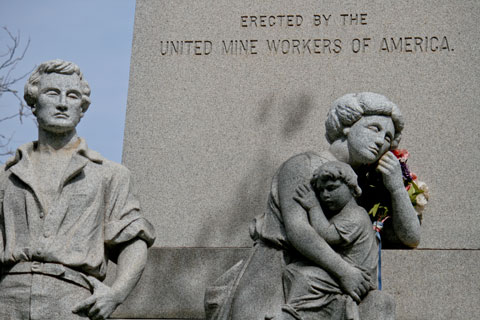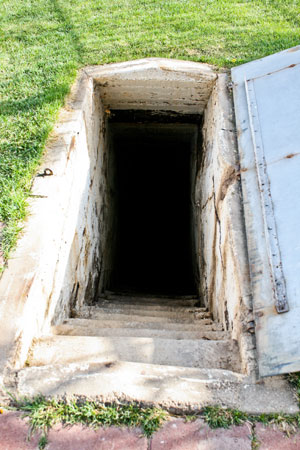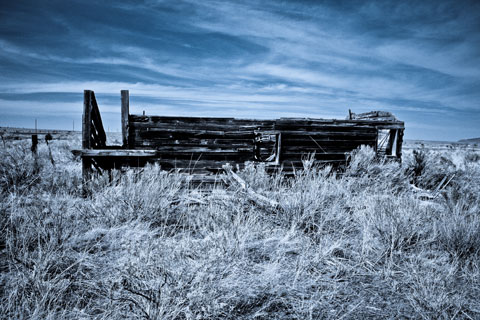Remembering the Ludlow Massacre
Part 4: The Ludlow memorial
Part 1 | Part 2 | Part 3 | Part 4
By Jack Hood
1 June 2012
In 1916, the UMW purchased a 40-acre site that included the former spot of the Ludlow tent colony, and two years later, the union built a small memorial to commemorate the lives of those killed in the massacre. The United States Secretary of the Interior added the memorial to the National Registry of Historical Places in 1985, and in 2009, the Ludlow Monument was designated a National Historical Landmark.
 The monument in Ludlow [Photo: Jozef Kubiš]
The monument in Ludlow [Photo: Jozef Kubiš]The monument serves as a testament to the bravery of the striking miners and their families. It also serves as a warning to workers today, reminding of the lengths capitalists will go to defend their property and profits.
A WSWS reporting team visited the site in early April, 2012.
The monument itself (renovated in recent years) is stark in its austere portrayal of the lives that were lost in the massacre. The site is situated 15 miles north of Trinidad on a flat, quiet prairie located approximately one mile west of Interstate 25 in Las Animas County. A small plot of land next to the site of the original tent colony has been turned into a gathering place for visitors, the center of which is a small fenced area with a lone 20-foot tall granite pillar. Standing next to the pillar, a severe looking miner gazes resolutely into the distance. A woman leans with closed eyes by his side, holding a small child her arms.
 The memorial statue [Photo: Jozef Kubiš]
The memorial statue [Photo: Jozef Kubiš]These figures seem to represent both survivor and victim—the man’s face reveals his fury, his eyes squint with disgust. The woman, leaning against her arm and protecting her child with her shoulder, remembers the fellow mothers who were killed by the thugs and guardsmen. Together, the family seems to stand as an icon for the American working class; they are beaten down, hungry, and brutalized, but they retain—in spite of all odds—their strength, their pride, and their staunch determination to bring an end to the injustice they face. They stand for the living memory of the events that took place nearly 100 years ago: the memory of the victims, of the perpetrators, and of the bravery of those who fought back.
The pillar stands only feet from the entryway to the Death Pit—the cellar in which 11 women and children were trapped and killed by the blazes set by the company thugs and National Guard. Few words can describe the claustrophobia that one feels when descending the steps into the dark, damp hole. The ceiling is low, and there is barely room to move. It is difficult to avoid thinking about the faces of the women and small children as they must have struggled to free themselves from the pit. One thinks too of the looks on the faces of the guardsmen as they rode through, setting the tents ablaze.
 Death pit [Photo: Jozef Kubiš]
Death pit [Photo: Jozef Kubiš]Beyond the pillar and the Death Pit, the dry, brown prairie stretches for miles. To the west and east, small outcroppings of hills block the horizon—the hills to which miners and their families fled on April 20th, 1914 and hid in the subsequent days as they regrouped, sharing stories of the terrors they witnessed.
Railroad tracks, still transporting coal to the northern mills, run alongside the camp. Two hundred yards along the tracks one can see Water Tank Hill, the slightly-raised spot from which guardsmen began shooting machine gun rounds into the camp on the morning of the 20th.
 The view from Water Tank Hill [Photo: Jozef Kubiš]
The view from Water Tank Hill [Photo: Jozef Kubiš]Situated next to the monument lies a large plot with no shrubs or chaparral—this is the now empty spot of the Ludlow tent colony. All that remains is a caved-in wooden pump house, the same structure that provided the striking miners with water through the long, cold winter of 1913-14.
Although the memorial is an emotionally powerful tribute to the men, women, and children who were massacred in the Ludlow battle, the monument unfortunately draws an equal sign between the violence of the state and the capitalists and the resistance of the workers.
 Tent site pump house [Photo: Jozef Kubiš]
Tent site pump house [Photo: Jozef Kubiš]“Violence on both sides plagued the strike,” reads one passage. Another panel reads: “Governor Elias Ammons called out the Colorado National Guard to keep the peace…” No explanation is offered for the actions of the Guardsmen in the subsequent massacre.
Finally, a panel lauds John D. Rockefeller for his humanitarianism, and credits the strike as a success because it pressured Rockefeller into adopting the Rockefeller Plan of reform industrialism: “The events of the Ludlow massacre outraged the nation and embarrassed John D, Rockefeller Jr.,” it reads. “This event initiated many of the labor reforms that workers now take for granted. As appeasement, Rockefeller introduced a plan that established a company sponsored union, instituted procedures to air grievances, and improved the living conditions in the company towns.”
John D. Rockefeller Jr. was not “embarrassed” into initiating reforms. He hired former Canadian Minister of Labor William Mackenzie King to carry out a massive public relations campaign to save the Rockefeller image. King and Rockefeller agreed that modest concessions would be necessary to “restore individual peace in the U.S. industries such as coal and fuel.”
In spite of these limitations, which reflect the complacent and pro-capitalist outlook of the UMW today, the memorial is well worth a visit.
Many workers who have visited the memorial have left behind written comments on the Ludlow Massacre:
3/27/11
“My father and his family lived in the area and were witnesses of the Ludlow Massacre from their hiding place in a cellar. He told the story many times of seeing some militia on horseback ride through, shooting anyone they saw.
-A miner and a miner’s son, Washington D.C.
8/5/11
“Solidarity amongst all workers is needed now more than ever to save us from the plutocracy handcuffing the human spirit. The 2-party system will enslave us all if we let it. ONLY by binding together can we defeat, stave off the great exploitation of those who work against the human family.
From Memphis to Madison, let freedom ring,
-male, Dwight, IL
9/27/11
“Orient 2 mine explosion survivor.
December, 1952, West Frankfurt, IL.
119 souls lost.
-male, for my Uncle. Thanks.
10/9/11
“This history needs to be told again and again so we don’t have to continue to bow down to the corporate oligarchs.”
-female, Reno, NV
Concluded





Follow the WSWS